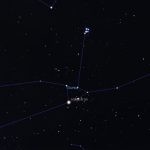| Meaning: | The Bull | Print out the star map from Sky and Telescope
Things to look for: Messier objects: Note: [x.x] indicates visual magnitude |
|
| Pronunciation: | tor’ us | ||
| Associated Asterisms: | The Hyades, The V, The Winter Oval | ||
| % of the sky: | 1.93% | ||
| Visible Stars: | 98 stars brighter than magnitude 5.5 |


Taurus is a very distinctive constellation rising in late evening in Autumn. The centre of the constellation is dominated by the asterism of the Hyades, the V shape containing the bright star Aldebaran, α Tau, on one limb. This is the 14th brightest star in the sky and was one of the four Royal Stars of the ancient Persians. The Hyades is the closest open cluster to the Solar System comprising a group of a hundred stars or so. Aldebaran is not a member of the cluster and is much closer to Earth even though, line of sight, it appears to be part of the group.
El Nath, β Tau, sits on the border of Taurus and Auriga and until the early 20th century it was shared between the constellations. It even used to have the designation γ Aur. Now it is firmly assigned only to Taurus.
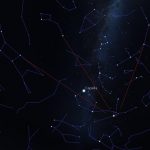

Taurus sits to the east of the Milky Way and if not immediately observable, it can be found in several different ways:
- The top of the Great Square of Pegasus can be followed to the west to the Hyades and Aldebaran;
- The top of the pan of the Big Dipper asterism can be followed to the east, again to the Hyades; or
- The tail of Ursa Minor through Polaris followed south to the Hyades.
Taurus, the Bull, appears in cave drawings so has quite a history of human interest even before Greek mythology suggested it might be Zeus changing form to abduct Europa or even Zeus’s mistress Io transformed to hide his indiscretion from his wife, Hera. The Hyades are the face of the bull and the two lines extending to the west are the horns tipped by Alcyone and El Nath.
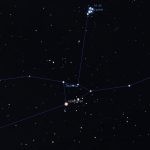
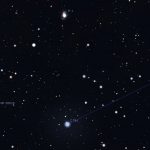
There are two Messier objects within the bounds of the constellation; M1 the Crab Nebula and M45 the Pleiades. The former is the remnant of the supernova explosion recorded by Chinese Astronomers in 1054. It is easily found in a telescope by hopping a degree or so north of Alcyone, the tip of the lower horn as shown in the image to the right. It is magnitude 8.4 and is 7 arc minutes in diameter; a quarter of the diameter of the Moon.
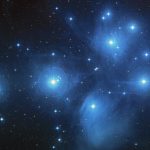

The Pleiades, M45, are also known as the Seven Sisters after the stars within it visible to the naked eye which make the shape of a question mark. The region is an area of stellar birth and contains many more new stars. Photographically the nebulosity enabling this new birth is quite visible. It is harder to make out in binoculars or telescopes but worth trying to see on darker, clearer skies. M45 is the brightest open cluster in the sky and probably because of this it wasn’t given a place in the more exhaustive NGC catalogue. The prominence and size of the cluster meant that in the ancient past it was considered a constellation in its own right. It is magnitude 1.6 and is over two Moon diameters in width.
Taurus is blessed with three meteor showers per year: β Taurids (29 Jun), Southern Taurids (3 Nov) and Northern Taurids (13 Nov).

